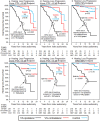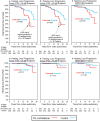Progression of Contralateral Hearing Loss in Patients With Sporadic Vestibular Schwannoma
- PMID: 33013614
- PMCID: PMC7461819
- DOI: 10.3389/fneur.2020.00796
Progression of Contralateral Hearing Loss in Patients With Sporadic Vestibular Schwannoma
Abstract
Background and Introduction: Vestibular schwannomas (VSs) are the most common tumors of the cerebellopontine angle, typically presenting unilaterally with ipsilateral sensorineural hearing loss (SNHL). The mechanism of tumor-induced hearing loss has recently been shown to be related to secreted tumor factors, in addition to mechanical compression of the adjacent auditory nerve, and these factors may percolate through CSF or blood to affect contralateral hearing as well. Methods: This is a retrospective study of medical records for patients treated for VS at Mass Eye and Ear from January 1994 through October 2018. Included patients had unilateral VS and sequential audiometry allowing for longitudinal assessment of hearing over time. Mass Eye and Ear's audiology database was used to select age- and sex-matched case controls, also with sequential audiometry, from the non-VS population. Subgroup analysis was performed by age, sex, baseline hearing, and tumor size at initial diagnosis. Hearing loss progression was performed using Kaplan-Meier analysis to account for variable follow-up times. Results: A total of 661 patients were identified with VS and sequential audiometry. The population was predominantly female vs. male (368 vs. 293, p = 0.0035), driven primarily by younger patients with Koos 4 tumors (76 female vs. 49 male, p = 0.016). Patients with normal baseline hearing bilaterally (N = 241) demonstrated no significant difference in hearing loss progression in VS-contralateral vs. control ears. Patients with abnormal baseline VS-ipsilateral hearing (N = 190), however, demonstrated significantly higher likelihood of reaching moderate SNHL in VS-contralateral ears. Subgroup analysis by age, sex, and baseline tumor size did not yield any subgroup-specific trends for hearing loss progression. Discussion and Conclusion: This is the largest study to date tracking long-term bilateral hearing outcomes in patients with VS, and demonstrates that, in patients with abnormal hearing in the VS-ipsilateral ear, there exists a long-term risk of progression to moderate hearing loss in the contralateral ear as well. Combined with the absence of significant changes in word understanding in the affected ears, these findings may provide clues to the nature of tumor-secreted factors involved in VS-associated hearing loss. Female predominance within the VS patient population is confirmed, driven mostly by younger female patients with Koos 4 tumors.
Keywords: contralateral; hearing loss; outcomes; secreted factors; vestibular schwannoma.
Copyright © 2020 Early, Rinnooy Kan, Eggink, Frijns and Stankovic.
Figures



Similar articles
-
Angiotensin-Receptor Blockers Prevent Vestibular Schwannoma-Associated Hearing Loss.Otol Neurotol. 2025 Feb 1;46(2):183-189. doi: 10.1097/MAO.0000000000004376. Otol Neurotol. 2025. PMID: 39792982 Free PMC article.
-
Human vestibular schwannoma reduces density of auditory nerve fibers in the osseous spiral lamina.Hear Res. 2022 May;418:108458. doi: 10.1016/j.heares.2022.108458. Epub 2022 Feb 7. Hear Res. 2022. PMID: 35334332 Free PMC article.
-
Accelerated Long-Term Hearing Loss Progression After Recovery From Idiopathic Sudden Sensorineural Hearing Loss.Front Neurol. 2021 Dec 8;12:738942. doi: 10.3389/fneur.2021.738942. eCollection 2021. Front Neurol. 2021. PMID: 34956043 Free PMC article.
-
Ipsilateral Cochlear Implantation in the Presence of Observed and Irradiated Vestibular Schwannomas.Ann Otol Rhinol Laryngol. 2020 Dec;129(12):1229-1238. doi: 10.1177/0003489420935482. Epub 2020 Jun 18. Ann Otol Rhinol Laryngol. 2020. PMID: 32551844 Review.
-
Congress of Neurological Surgeons Systematic Review and Evidence-Based Guidelines on Hearing Preservation Outcomes in Patients With Sporadic Vestibular Schwannomas.Neurosurgery. 2018 Feb 1;82(2):E35-E39. doi: 10.1093/neuros/nyx511. Neurosurgery. 2018. PMID: 29309683
Cited by
-
Sporadic Vestibular Schwannoma Size and Location Do not Correlate With the Severity of Hearing Loss at Initial Presentation.Front Oncol. 2022 Mar 15;12:836504. doi: 10.3389/fonc.2022.836504. eCollection 2022. Front Oncol. 2022. PMID: 35372070 Free PMC article.
-
Current Understanding of Hearing Loss in Sporadic Vestibular Schwannomas: A Systematic Review.Front Oncol. 2021 Aug 12;11:687201. doi: 10.3389/fonc.2021.687201. eCollection 2021. Front Oncol. 2021. PMID: 34476211 Free PMC article.
-
Angiotensin-Receptor Blockers Prevent Vestibular Schwannoma-Associated Hearing Loss.Otol Neurotol. 2025 Feb 1;46(2):183-189. doi: 10.1097/MAO.0000000000004376. Otol Neurotol. 2025. PMID: 39792982 Free PMC article.
-
[Clinical characteristics of acoustic neuroma patients with normal hearing].Lin Chuang Er Bi Yan Hou Tou Jing Wai Ke Za Zhi. 2022 Dec;36(12):897-901. doi: 10.13201/j.issn.2096-7993.2022.12.002. Lin Chuang Er Bi Yan Hou Tou Jing Wai Ke Za Zhi. 2022. PMID: 36543395 Free PMC article. Chinese.
-
Human vestibular schwannoma reduces density of auditory nerve fibers in the osseous spiral lamina.Hear Res. 2022 May;418:108458. doi: 10.1016/j.heares.2022.108458. Epub 2022 Feb 7. Hear Res. 2022. PMID: 35334332 Free PMC article.
References
-
- Mahaley MS, Mettlin C, Natarajan N, Laws ER, Peace BB. Analysis of patterns of care of brain tumor patients in the United States: a study of the Brain Tumor Section of the AANS and the CNS and the Commission on Cancer of the ACS. Clin Neurosurg. (1990) 36:347–52. - PubMed
Grants and funding
LinkOut - more resources
Full Text Sources

